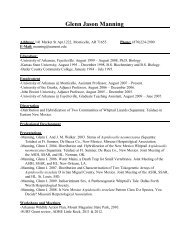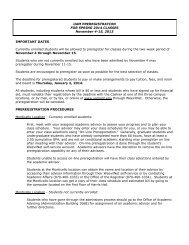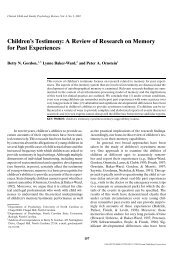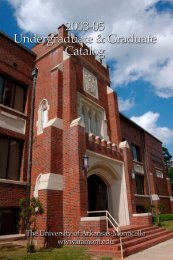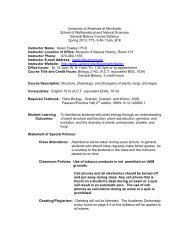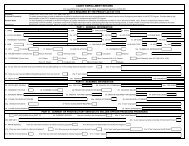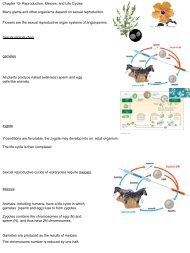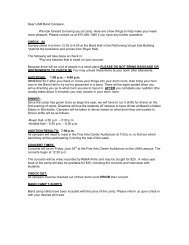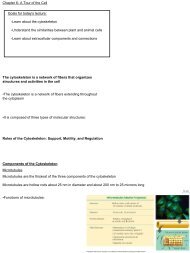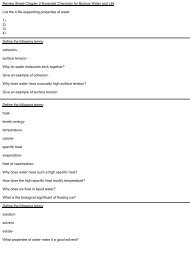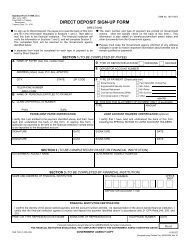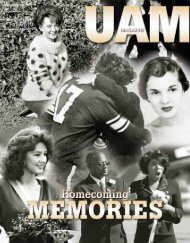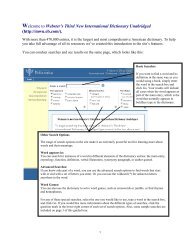annual assessment report - University of Arkansas at Monticello
annual assessment report - University of Arkansas at Monticello
annual assessment report - University of Arkansas at Monticello
You also want an ePaper? Increase the reach of your titles
YUMPU automatically turns print PDFs into web optimized ePapers that Google loves.
D<strong>at</strong>a show th<strong>at</strong> students improve their ability to think cre<strong>at</strong>ively, can look <strong>at</strong> connections<br />
(similarities and differences) between their n<strong>at</strong>ive tongue and Spanish, and are able to<br />
synthesize inform<strong>at</strong>ion about syntax, diction, dialects, liter<strong>at</strong>ure, history, culture, as well<br />
as specialized inform<strong>at</strong>ion they receive in seminars on topics such as Spanish for medical<br />
personnel, Spanish for pr<strong>of</strong>essionals working with Hispanic clientele, and AP Spanish in<br />
review.<br />
One area <strong>of</strong> concern is the ability <strong>of</strong> Spanish students to listen and understand the spoken<br />
language when used in a n<strong>at</strong>ural setting with n<strong>at</strong>ives who do not always speak standard<br />
Spanish. We are hoping to enhance our labor<strong>at</strong>ory facilities to provide students with<br />
access to s<strong>of</strong>tware th<strong>at</strong> enables them to communic<strong>at</strong>e with speakers <strong>of</strong> various Spanish<br />
speaking countries in a n<strong>at</strong>ural setting. Some efforts have already been made with the<br />
help <strong>of</strong> our Fulbright scholars, such as weekly “Tertulias” (g<strong>at</strong>herings <strong>of</strong> friends). Our<br />
Fulbright scholars have also been able to connect Spanish students with n<strong>at</strong>ive Spanish<br />
speakers via SKYPE, but our labor<strong>at</strong>ory facilities need to improve to make such<br />
exchange accessible to a larger number <strong>of</strong> participants.<br />
French and L<strong>at</strong>in Assessment<br />
Because it is quick and reliable, the “Gain Scores” approach was used to measure<br />
changes in students‟ behaviors toward demonstr<strong>at</strong>ion <strong>of</strong> the Expected Student Learning<br />
Outcomes. Expected knowledge for post tests was set <strong>at</strong> 90 (A-). It could have been set <strong>at</strong><br />
70, or even 65 (C or D) as these are valid passing grades; but we wanted to set high<br />
standards. Students s<strong>at</strong>isfying the desired direction <strong>of</strong> change from pre- to post test<br />
indic<strong>at</strong>e th<strong>at</strong> French and L<strong>at</strong>in program effects are positive. These students enjoy a<br />
remarkable level <strong>of</strong> learning from the start to the conclusion <strong>of</strong> each course. Students are<br />
significantly improving their knowledge and skill levels in all areas: speaking, reading,<br />
writing, and culture.<br />
5. Other than course level/grades, describe/analyze other d<strong>at</strong>a and other sources <strong>of</strong><br />
d<strong>at</strong>a whose results assist your unit in improving student learning.<br />
Early College Assessment Tests–Spanish 1013 Elementary I, years 2008-2012<br />
The following high schools particip<strong>at</strong>e in the Early College program provided by the<br />
Southeast <strong>Arkansas</strong> Educ<strong>at</strong>ional Cooper<strong>at</strong>ive: Cornerstone, Dermott, Piggott, Quitman,<br />
and Star City. Student Learning Outcomes and grading standards are aligned with<br />
UAM‟s.<br />
The <strong>assessment</strong> test (see Appendix C) is written and is entirely in Spanish, calling for<br />
written responses, and therefore measures whether students demonstr<strong>at</strong>e Student<br />
Learning Outcomes 3 and 4:<br />
<br />
<br />
“Understand the written language as used in practical daily life involving learned<br />
vocabulary”<br />
“Write the language as used in practical daily life involving learned vocabulary.”<br />
The test is given in two parts, parts A and B, each having equal (or 50%) value. A<br />
student scoring 60% or better has demonstr<strong>at</strong>ed the expected outcomes. The only student



